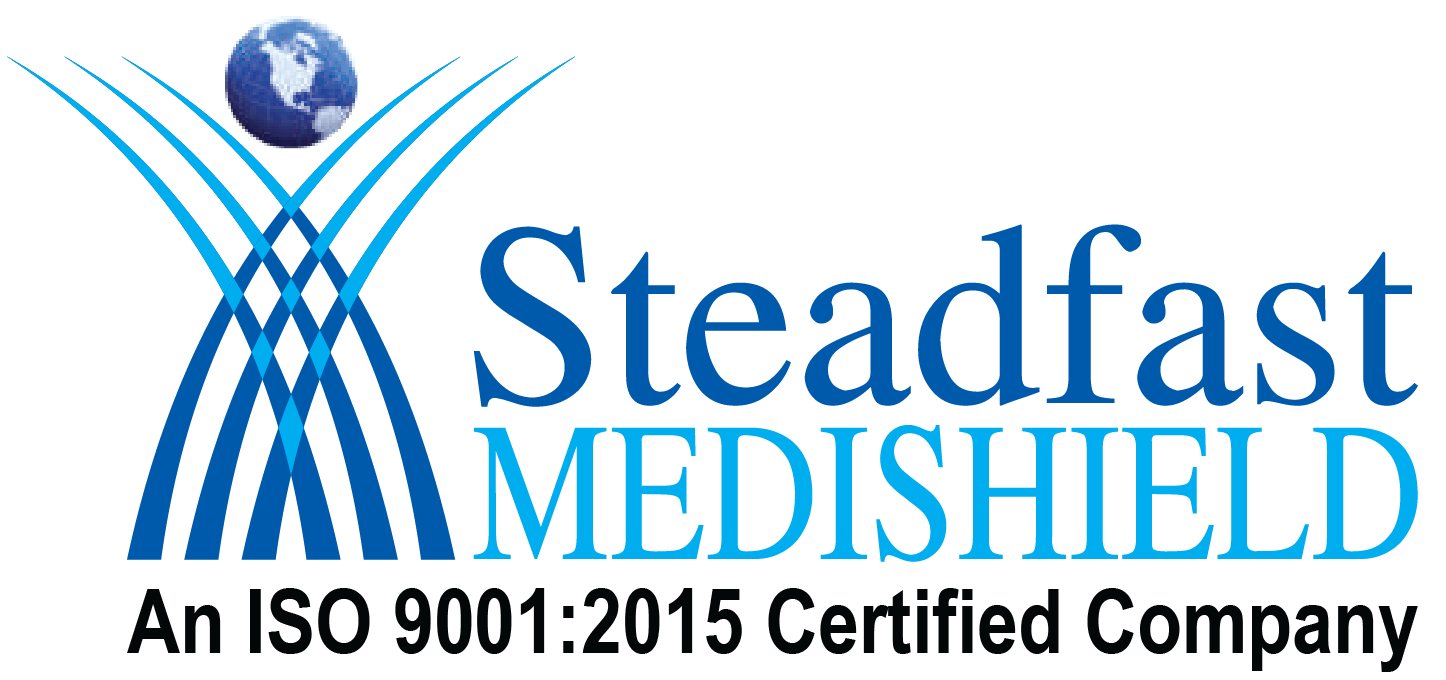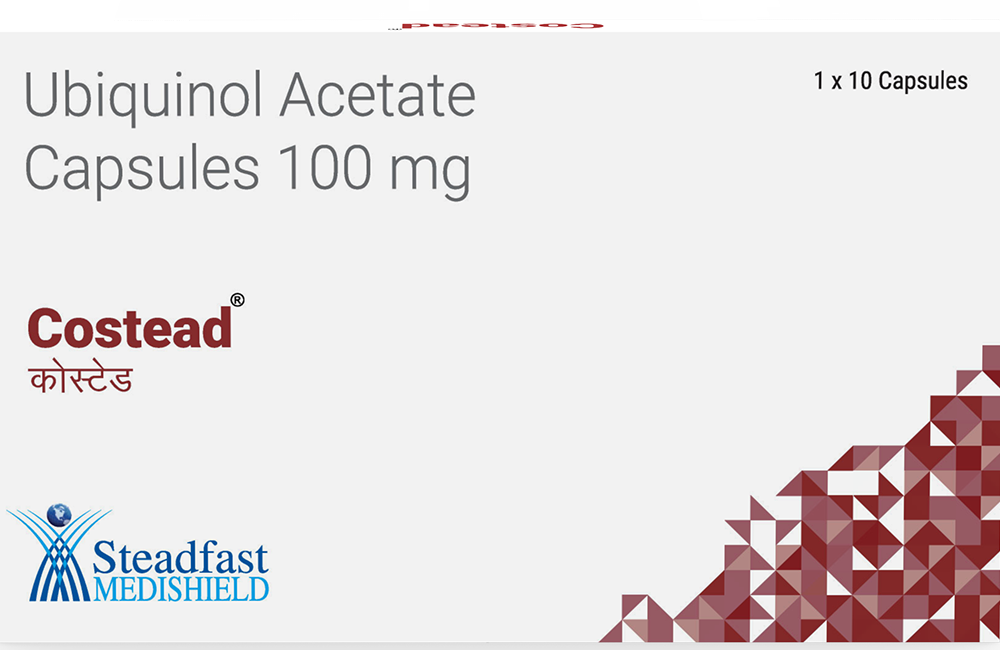DESCRIPTION
Ubiquinol (CoQH2) in Costead is a reduced form of coenzyme Q10 (CoQ10) that acts as an active antioxidant that prevents the initiation and propagation of lipid peroxidation in biological membranes and human low-density lipoprotein (LDL). It plays an essential role in maintaining cellular defence against oxidative damage and also sustains the effects of vitamin E by regenerating the vitamin from the tocopheroxyl radical.
Key Benefits:-
• Costead decreases Oxidative stress
• Costead Improves kidney health
• Costead boosts immunity and enhances heart health.
MECHANISM OF ACTION
CoQ10 / Ubiquinol participates in the mitochondrial electron transport chain as a cofactor at the level of Complex III where it shunts electrons. It also acts as a lipophilic antioxidant in the mitochondrial membranes.
PHARMACOKINETICS
Ubiquinol is administered orally. Being lipophilic, it follows the uptake mechanisms of lipids in the gastrointestinal tract. Ubiquinol is first incorporated into chylomicrons following absorption and transported via the lymphatics to the circulation. There it is transported by triacylglycerol-rich lipoproteins to the liver where it is repackaged primarily into VLDL/LDL particles and HDL particles to a minor extent. About 95% of CoQ10 in circulation exists in its reduced form as Ubiquinol in humans.3,4 A major portion of CoQ10 in tissues is in the reduced form as Ubiquinol.5
CoQ10 has a Tmax of 6.5 h and an elimination half-life of 33.19 h. Chronic administration produces a dose-dependent increase in plasma CoQ10. Compared to CoQ10, administration of Ubiquinol raises serum levels 2-fold higher with chronic dosing and over 4-fold higher with acute dosing.6
INDICATIONS AND OTHER KNOWN CLINICAL USE
Supplementation with Ubiquinol replenishes depleted levels and circumvents CoQ10 deficiency.1,2,7-8
CoQ10 deficiency has been reported in congestive heart failure,9,10 Type 2 diabetes,11,12 hepatitis,13 liver cirrhosis,13 hepatocellular carcinomas,13 ALS,14 Alzheimer’s disease,15 juvenile fibromyalgia16 and Down’s syndrome.17
Statin drugs inhibit the endogenous production of CoQ10, which has been implicated in fatigue and myalgia; Ubiquinol replenishes CoQ10 stores in these patients.18,19
Supplementation with Ubiquinol improves dyslipidemia-related endothelial function and increases serum nitric oxide levels.20,21
DOSAGE & ADMINISTRATION
As a dietary supplement, intended for a daily intake of 100-300 mg
Recommended Use:
100 mg/d – Maintenance dose
200 mg/d – To replenish Ubiquinol levels and correct deficiencies
300 mg/d – For more severe deficiencies or to dose load initially and then decrease to 200 mg
ADMINISTRATION
Oral administration
STORAGE
Store at controlled room temperature (68-77° F)
CONTRAINDICATIONS / PRECAUTIONS
None
ADVERSE REACTIONS
Costead is generally well tolerated. As with any dietary supplement, some gastrointestinal discomfort may be experienced.
DRUG INTERACTIONS
Because of its structural similarity to vitamin K, it has been suggested that CoQ10 may have procoagulant activity and interfere with warfarin. While there are reports of individual case studies showing the interaction of CoQ10 and warfarin,22,23 other case studies involving highly monitored patients on warfarin specifically noted no interactions with CoQ10. 9 A randomized, double-blind, placebo-controlled study designed to assess the effect of CoQ10 on warfarin also showed no effect.24 A prospective study did show an interaction, though by admission of the authors, the results may have been due to chance given a small population that self-reported the data.25
Until the dynamics of warfarin, vitamin K and CoQ10 are better understood, patients taking these products together should be closely monitored by the prescribing physician. Administration of Ubiquinol may be appropriate for many individuals taking coumarin or other blood-thinning medications. The addition of any nutrient or changes to the diet, or even gradual changes in medication dosage levels, demands close patient monitoring to ensure maintenance of INR within the acceptable range. Emerging pharmacogenomic data indicates that people with certain genotypes may be more susceptible to variables influencing warfarin activity, sensitivity and resistance.26
PREGNANCY AND LACTATION
There are no adequate and well-controlled studies in pregnant or lactating women to establish safety.
REFERENCES
1. Hosoe K, Kitano M, Kishida H, Kubo H, Fujii K, Kitahara M. Study on safety and bioavailability of ubiquinol (Kaneka QH) after single and 4-week multiple oral administration to healthy volunteers. Regul Toxicol Pharmacol. 2007 Feb;47(1):19-28.
2. Miles MV, Horn P, Milesc L, Tanga P, Steele P, DeGrauwa T. Bioequivalence of coenzyme Q10 from over-the-counter supplements. Nutr Res. 2002:22(8):919-929.
3. Yamashita S, Yamamoto Y. Simultaneous detection of ubiquinol and ubiquinone in human plasma as a marker of oxidative stress. Anal Biochem. 1997 Jul 15;250(1):66-73.
4. Tang PH, Miles MV, DeGrauw A, Hershey A, Pesce A. HPLC analysis of reduced and oxidized coenzyme Q(10) in human plasma. Clin Chem. 2001 Feb;47(2):256-65.
5. Aberg F, Appelkvist EL, Dallner G, Ernster L. Distribution and redox state of ubiquinones in rat and human tissues. Arch Biochem Biophys. 1992 Jun;295(2):230-4.
6. Bhagavan HN, Chopra RK. Coenzyme Q10: absorption, tissue uptake, metabolism and pharmacokinetics. Free Radic Res. 2006 May;40(5):445-53.
7. Evans M, Baisley J, Barss S, Guthrie N. A randomized, double-blind trial on the bioavailability of two CoQ10 formulations. Journal of Functional Foods. 2009. 1: 65-73.
8. Mohr D, Bowry VW, Stocker R. Dietary supplementation with coenzyme Q10 results in increased levels of ubiquinol-10 within circulating lipoproteins and increased resistance of human low-density lipoprotein to the initiation of lipid peroxidation. Biochim Biophys Acta. 1992 Jun 26;1126(3):247-54.
9. Langsjoen PH, Langsjoen AM. Supplemental ubiquinol in patients with advanced congestive heart failure. Biofactors. 2008;32(1-4):119-28.
10. Langsjoen PH and Langsjoen AM. Supplemental Ubiquinol in congestive heart failure: 3 year experience. 6th International Q10 Conference Brussels, 27–30 May 2010; 29–30.
11. Lim SC, Tan HH, Goh SK, Subramaniam T, Sum CF, Tan IK, Lee BL, Ong CN. Oxidative burden in prediabetic and diabetic individuals: evidence from plasma coenzyme Q(10). Diabet Med. 2006 Dec;23(12):1344-9.
12. Ates O, Bilen H, Keles S, Alp HH, Keleş MS, Yıldırım K, Ondaş O, Pınar LC, Civelekler M, Baykal O. Plasma coenzyme Q10 levels in type 2 diabetic patients with retinopathy. Int J Ophthalmol. 2013 Oct 18;6(5):675-9.
13. Yamamoto Y, Yamashita S. Plasma ubiquinone to ubiquinol ratio in patients with hepatitis, cirrhosis, and hepatoma, and in patients treated with percutaneous transluminal coronary reperfusion. Biofactors. 1999;9(2-4):241-6.
14. Sohmiya M, Tanaka M, Suzuki Y, Tanino Y, Okamoto K, Yamamoto Y. An increase of oxidized coenzyme Q-10 occurs in the plasma of sporadic ALS patients. J Neurol Sci. 2005 Jan 15;228(1):49-53.
15. Isobe C, Abe T, Terayama Y. Increase in the oxidized/total coenzyme Q10 Q-10 ratio in the cerebrospinal fluid of Alzheimer’s disease patients. Dement Geriatr Cogn Disord. 2009;28(5):449-54.
16. Miyamae T, Seki M, Naga T, Uchino S, Asazuma H, Yoshida T, Iizuka Y, Kikuchi M, Imagawa T, Natsumeda Y, Yokota S, Yamamoto Y. Increased oxidative stress and coenzyme Q10 deficiency in juvenile fibromyalgia: amelioration of hypercholesterolemia and fatigue by ubiquinol-10 supplementation. Redox Rep. 2013;18(1):12-9.
17. Miles MV, Patterson BJ, Chalfonte-Evans ML, Horn PS, Hickey FJ, Schapiro MB, Steele PE, Tang PH, Hotze SL. Coenzyme Q10 (ubiquinol-10) supplementation improves oxidative imbalance in children with trisomy 21. Pediatr Neurol. 2007 Dec;37(6):398-403.
18. Zlatohlavek L, Vrablik M, Grauova B, Motykova E, Ceska R. The effect of coenzyme Q10 in statin myopathy. Neuro Endocrinol Lett. 2012;33 Suppl 2:98-101.
19. Fedacko J, Pella D, Fedackova P, Hänninen O, Tuomainen P, Jarcuska P, Lopuchovsky T, Jedlickova L, Merkovska L, Littarru GP. Coenzyme Q(10) and selenium in statin-associated myopathy treatment. Can J Physiol Pharmacol. 2013 Feb;91(2):165-70.
20. Sabbatinelli J, Orlando P, Galeazzi R, Silvestri S, Cirilli I, Marcheggiani F, Dludla PV, Giuliani A, Bonfigli AR, Mazzanti L, Olivieri F, Antonicelli R, Tiano L. Ubiquinol ameliorates endothelial dysfunction in subjects with mild-to-moderate dyslipidemia: A randomized clinical trial. Nutrients. 2020 Apr 15;12(4):1098.
21. Kawashima C, Matsuzawa Y, Konishi M. et al. Ubiquinol improves endothelial function in patients with heart failure with reduced ejection fraction: A single-center, randomized double-blind placebo-controlled crossover pilot study. Am J Cardiovasc Drugs. 2019.
22. Spigset O. Reduced effect of warfarin caused by ubidecarenone. Lancet. 1994 Nov 12;344(8933):1372-3.
23. Landbo C, Almdal TP. [Interaction between warfarin and coenzyme Q10]. Ugeskr Laeger. 1998 May 25;160(22):3226-7. [Article in Danish]
24. Engelsen J, Nielsen JD, Winther K. Effect of coenzyme Q10 and Ginkgo biloba on warfarin dosage in stable, long-term warfarin treated outpatients. A randomised, double blind, placebo-crossover trial. Thromb Haemost. 2002 Jun;87(6):1075-6.
25. Shalansky S, Lynd L, Richardson K, Ingaszewski A, Kerr C. Risk of warfarin-related bleeding events and supratherapeutic international normalized ratios associated with complementary and alternative medicine: a longitudinal analysis. Pharmacotherapy. 2007 Sep;27(9):1237-47.
26. Stargrove MB, Treasure J, McKee DL. Herb, Nutrient and Drug Interactions:Clinical implications and therapeutic strategies. Mosby Elsevier, St. Louis, Missouri, 2008, p. 743.

